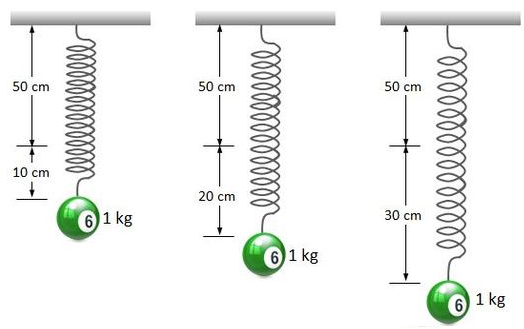Harmonic spring

When a ball with mass 1 kg is hung on a 5 0 cm long spring, the length of the spring is increased by 1 0 cm in steady state, as shown in the far left diagram. Now, suppose that we pull this ball further down and let it go. Then it will show simple harmonic oscillations. What will be the periods of these oscillations when we pull down the ball by 1 0 cm and 2 0 cm, respectively, as shown in the middle and right diagrams above?
Gravitational acceleration is 1 0 m/s 2 .
This section requires Javascript.
You are seeing this because something didn't load right. We suggest you, (a) try
refreshing the page, (b) enabling javascript if it is disabled on your browser and,
finally, (c)
loading the
non-javascript version of this page
. We're sorry about the hassle.
3 solutions
life is always easy when basics are within us
thanks for answer. can you explain why 2pi into root over l divided by g formula isn't use here ?
Log in to reply
thats the formula for a pendulum in small angle oscillations, not a spring
its 2 pi (l/g)^0.5........in the second case it should have been 0.2pi*2^1/2
Hey, I went to level 2 of this particular question and I accidently selected the wrong option and lost it... Can I proceed to level 3 of this kind?? Please, tell me a way to find this type's level 3.... Please!!!
It is NOT necessary to calculate k.
But I will write how to do the whole thing.
( 1 kg ) ( 1 0 m s − 2 ) = k ⋅ ( 0 . 1 m ) k = 1 0 0 N m − 1 T = 2 π k m = 2 π 1 0 0 N m − 1 1 kg T = 0 . 2 π s
Note that, as T does not vary with amplitude (but only with mass and spring constant), T 1 = T 2
so easy. T is independent of amplitude. That is = 2*3.148root of(m/k)
You are right. I solved this problem in this process.
Time period of Harmonic motion is independent of amplitude.. And is equal to 2 p i k m